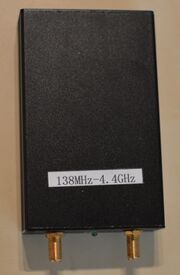Difference between revisions of "BG7TBL"
Jump to navigation
Jump to search
(→Query firmware: firmware version is also 'w') |
(→Protocol: + sample code to check the firmware (4 Python lines)) |
||
| Line 44: | Line 44: | ||
Where the returned byte is the firmware version, 0x77 = 119 = 'w'. | Where the returned byte is the firmware version, 0x77 = 119 = 'w'. | ||
<pre> | |||
#!/usr/bin/python | |||
import serial | |||
ser = serial.Serial('/dev/ttyUSB0', 57600, timeout=1) # Linux first FTDI | |||
ser.write("\x8f" + "v") | |||
print("version is " + ser.read()) | |||
</pre> | |||
=== Signal generator === | === Signal generator === | ||
Revision as of 08:00, 19 May 2018
 | |
| Status | planned |
|---|---|
| Frequency (user) | 138MHz-4.4GHz |
| Waveforms | sine (fixed) |
| Amplitude | ? V |
| Connectivity | USB |
The BG7TBL USB RF Signal Generator is a PC-based function generator. It has no external controls, requiring a USB connection to a computer.
Software to run this hardware can be found here http://www.dl4jal.eu/.
This device can be bought on ebay for ca $65. Search for "138MHz-4.4GHz". There is a version with the ADF4351 instead that will give you more range (35MHz-4.4GHz).
Hardware
- Microcontroller: Atmel Atmega 8L
- Wideband Synthesizer: ADF4350
- USB to Serial: FTDI FT232RL
- Logarithmic Amplifier AD8307
- Mixer: IAM 81008
- LDO: AMS1117
Photos
Protocol
Baud 57600, 8n1
The protocol is binary serial based.
Query firmware
- Send 0x8f+"v"
The answer should be in hex:
- 77
Where the returned byte is the firmware version, 0x77 = 119 = 'w'.
#!/usr/bin/python
import serial
ser = serial.Serial('/dev/ttyUSB0', 57600, timeout=1) # Linux first FTDI
ser.write("\x8f" + "v")
print("version is " + ser.read())
Signal generator
Setting frequency
To set a frequency send:
- 0x8f
Then f and then the frequency divided by 10 with leading zeroes. For example this is the payload for 400MHz.
- 400 000 000 / 10
- f040000000
Spectrum analyzer
The protocol is briefly described in the source code here:

